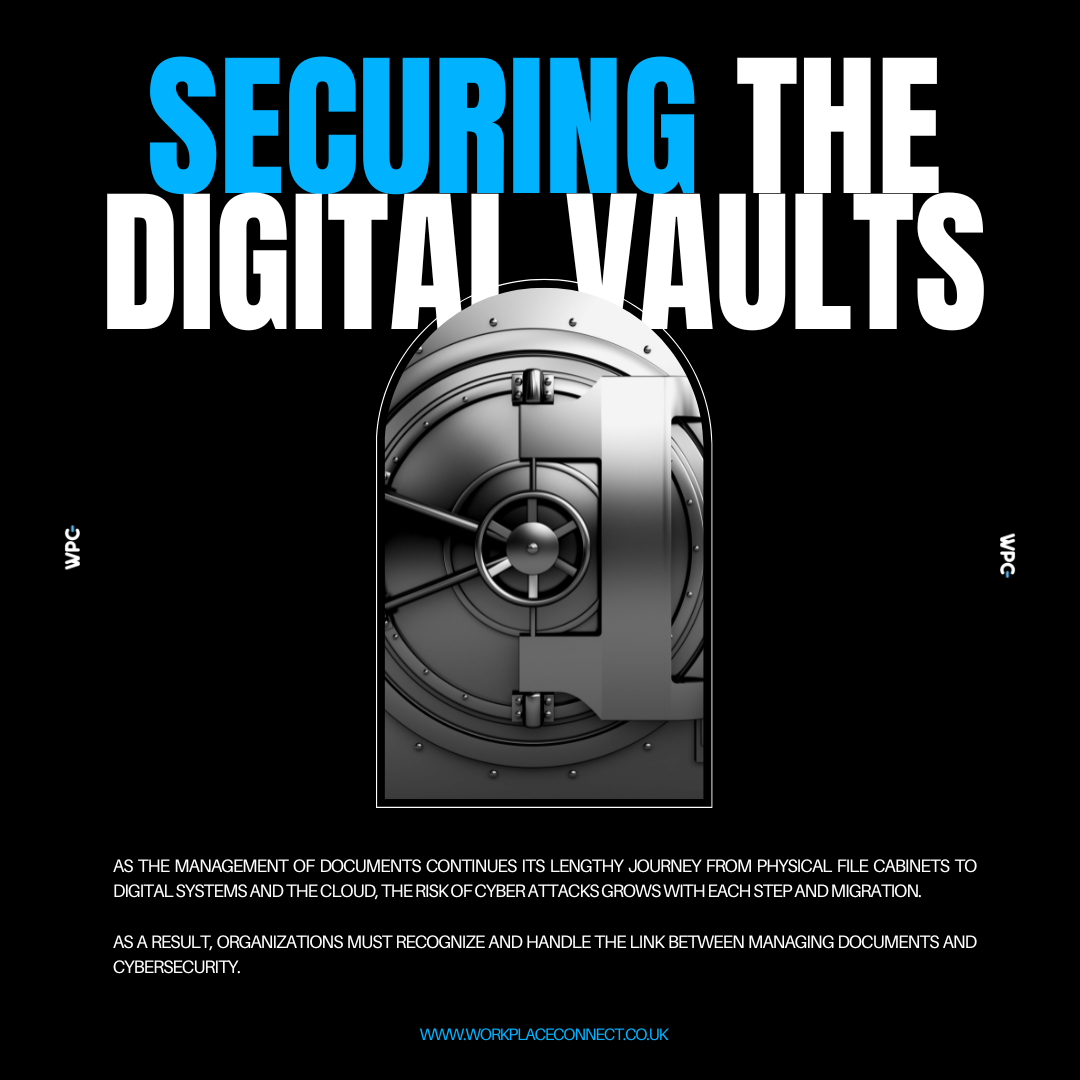Untold amounts of sensitive data are stored in the vast number of documents that are amassed throughout the course of an organisation’s existence. It should be a high concern to keep them safe regardless of where they are stored.
As the management of documents continues its lengthy journey from physical file cabinets to digital systems and the cloud, the risk of cyber attacks grows with each step and migration. As a result, organisations must recognise and handle the link between managing documents and cybersecurity.
Document management security is critical because documents contain some of the most confidential corporate materials. It could be intellectual property, financial information, or employee or customer data – all of which is stored in spreadsheets, Word documents, or PDFs.
We must guarantee that these corporate data repositories are adequately protected, as poor handling techniques might result in unintended leakage or unauthorised disclosure via email.
Since the introduction of document management systems in the 1970s, the widespread adoption of personal computers in the 1990s, the expansion of the internet, and the widespread adoption of cloud-based document management systems, information digitisation has gradually transformed how organisations handle documents.
This trend currently includes the use of artificial intelligence and machine learning to improve document searches, as well as an emphasis on automation, data analytics, and increased security measures. These safeguards, once known as ‘information security,’ have existed since Caesar’s reign. Cybersecurity, or information security modernisation, explicitly addresses the safety of digital assets and the system that supports them.
In this view, information security stays within the broader scope and relates to document management. The digitisation of these papers is a goal of cybersecurity. Understanding the convergence between cybersecurity and managing documents is essential for protecting sensitive data.
Critical Principles at The Crossroads of Cybersecurity and Document Management
Data security, compliance, and risk management are important ideas held by both cybersecurity and document management. Data security is critical to this intersection because it guarantees that documents are saved and transmitted safely, when in use, at rest, or in motion. To protect data against unauthorised access, use, disclosure, interruption, alteration, or destruction, encryption, controls on access, and other security measures must be implemented.
Compliance refers to the regulatory, legal, and policy framework that surrounds document management. Organisations must follow these guidelines, which include data retention, destruction, and the development of audit trails. Compliance guarantees that data is not only secured but also managed within the legal framework.
Risk management, which involves recognising, assessing, and managing hazards, is another important issue at the confluence of cybersecurity and document management.
This entails creating and implementing security procedures and guidelines that are adapted to the organisation’s specific demands, including compliance. Regular security audits and personnel security best practises training are critical components of risk control.
Document management and cybersecurity have common interests in important ideas across an organisation’s document lifecycle, from the necessity of proper classification to the articulation of acceptable means of accessing the application of preservation and destruction standards. For example, allowing efficient and successful document management begins with the proper classification of those resources.
Similarly, security is dependent on effective classification in order to detect and safeguard documents based on applicable needs. It’s difficult to picture an organisation’s document lifecycle without understanding the convergence between document management and cybersecurity.
The Integration of Security Into Strategic Evaluations For Document Management
According to Jennifer Glenn, research director for data and information security at IDC, many vendors from “data-security-adjacent” technologies are gaining traction in the data security arena. “Content and document management is one area,” she goes on to say. “To me, this says that companies are very aware of the security/privacy risks connected with their document management and take steps to secure that piece of business activity.”
Furthermore, data security strategy should inform document management so that it is clear who is given access to various data stores, how that data is encrypted – if at all – if that data requires anonymity, for how long data must be kept, and how data should be destroyed after applicable retention timelines have been met. All of these variables should be considered when determining how a company handles the document management lifecycle from beginning to conclusion.
Any strategy review for document management should include security issues. When selecting essential objectives, firms may, for example, highlight enhanced efficiency, lower expenses, and increased collaboration. Given the huge cyber dangers that enterprises face in our quickly digitised environment, it is critical that the company establishes a clear goal to safeguard data, documents, and networks from the start.
Security must be incorporated into all aspects of the document management evaluation, including the current status analysis and roadmap articulation. The incorporation of cybersecurity into these phases not only assists in identifying the baseline regulations that will influence the strategy but also the abilities that the company will require to achieve those requirements.
According to Jeffrey Bernstein, director of cybersecurity and data privacy in the risk advisory services department at Kaufman Rossin, a CPA and consultancy business, security is a crucial enabler of success within any organisation and has become a top strategic objective for all successful Internet-connected companies. “Because of this, most successful companies are transforming the way they operate to enhance security and compliance efforts, improve efficiency, and optimize operations via the implementation of document management programs,” he said.
Procedures for Integrating Cybersecurity Into Systems For Document Management
Because there are various teams with varying budgets and business objectives, the first step is always to synchronise the departments’ desired outcomes. The actions that follow are based on the key questions that must be addressed to ensure successful data and information security:
- My data—where is it? Before exchanging any data or information, you must first know where it is and how it is being stored.
- What exactly is my data? Next, you must comprehend what you are dealing with. What kinds of information are contained in these documents? What graphics or material are contained in the documents under management? And is that information sensitive, such as credit card details, or confidential, such as intellectual property? Data discovery and classification tools are frequently employed in this context to uncover and categorise this content based on its potential danger to the business.
- Who has access to my information? It is also critical to establish who is exchanging papers and with whom they are sharing documents/information. Data leakage, which occurs when trusted users share information with those who should not have it, is a real risk for document management. To see who is sending what, a cloud access security broker and information leakage prevention solutions can be effective. These technologies can then detect and block unusual connections.
- Is my data properly safeguarded? Controls are provided by organisations such as Box and Egnyte that limit access to certain documents depending on content, users, their responsibilities and privileges, and timing, for example, do they gain access to documents during an ongoing project?
Optimal Approaches For The Secure Storage and Sharing of Documents
The best practises for safe document storage and sharing can be divided into areas that contribute to a holistic strategy for protecting private data from potential cyber threats. These categories include:
- Data classification and security methods include document classification based on sensitivity, protecting stored documents and data in transit, imposing rigorous controls on access, and using multi-factor authentication for content access.
- Collaboration and user training include techniques such as using secure collaboration platforms and teaching employees about cybersecurity and best practises for document management.
- Continuously monitoring document access and modifications, as well as building a well-defined incident response strategy, are examples of monitoring and response procedures.
- Establishing explicit retention and disposal standards, as well as making sure that document management adheres to industry regulations, are all part of policy and compliance.
- Backup and data security methods include backing up your documents on a regular basis and using reliable cloud providers with strict data security standards.
- Software and vendor management entails keeping software and tools up to date as well as ensuring third-party providers adhere to security standards.
- Developing a strategy for unanticipated circumstances, employing secure file transfer techniques for sharing papers, and blocking access for departing staff are all examples of business continuity and safe sharing practises.







